 Whiteface Mountain, Moose Mountain and McKenzie Mountain, from Lake Clear
Whiteface Mountain, Moose Mountain and McKenzie Mountain, from Lake Clear  5839 New York Route 30, Lake Clear
5839 New York Route 30, Lake Clear 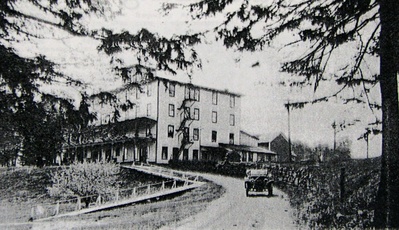 The approach to Lake Clear Inn, 1912. (Photo courtesy of George Carley) Adirondack Daily Enterprise, October 28, 1989
The approach to Lake Clear Inn, 1912. (Photo courtesy of George Carley) Adirondack Daily Enterprise, October 28, 1989 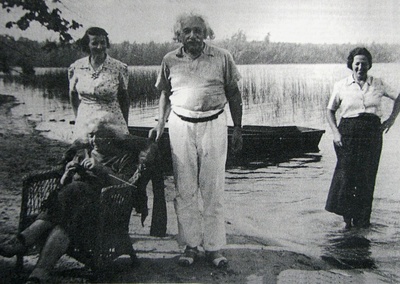 Albert Einstein with his wife (seated) vacationing at Lake Clear. Adirondack Daily Enterprise, August 19, 1989
Albert Einstein with his wife (seated) vacationing at Lake Clear. Adirondack Daily Enterprise, August 19, 1989
Lake Clear is a hamlet and a lake in Franklin County. The area is named for 940-acre Lake Clear, part of the original Seven Carries canoe route. New York Route 30 is the principal route through the hamlet. The lake was originally called Big Clear Pond, to distinguish it from Little Clear Pond.
In the late 1800s, Lake Clear was near the center of a thriving tourist industry; Upper Saint Regis Lake, three miles to the north, is home to some of the earliest and most elite of the Great Camps, and Paul Smith's Hotel was only five miles to the north. Saranac Inn, on the shore of Upper Saranac Lake, is four miles to the west, and the village of Saranac Lake is six miles to the southeast. In 1893, the Mohawk and Malone Railway reached Lake Clear at Saranac Inn Station, and in 1906, Paul Smith built an electric railroad that ran from Lake Clear Junction to his hotel.
Many of the area's great camps and cottages are still in use, along with other guest facilities. The nearby St. Regis Canoe Area is a major draw for paddlers. The state now owns much of the land, including most of the shoreline of Lake Clear, and it operates a Fish Hatchery at nearby Little Clear Pond.
The Adirondack Regional Airport, owned and operated by the Town of Harrietstown, is 1.5 miles east of Lake Clear; although it is nominally in Saranac Lake (though not within Village boundaries), it is known locally as the "Lake Clear Airport." 12
George H. Carley, Sr. ran a general store in Lake Clear, and was its first postmaster and mail carrier. The Lake Clear Inn has operated since 1912. The village was also the site of the Montvue Hotel
See also:
Sources
- Donaldson, Alfred L., A History of the Adirondacks. New York: Century, 1921. ISBN 0-916346-26-8. (reprint)
- Jerome, Christine Adirondack Passage: Cruise of Canoe Sairy Gamp, HarperCollins, 1994. ISBN 0-93527294-1.
Adirondack Daily Enterprise, October 28, 1989
Two RR junctions helped Village thrive
A. Judd Northrup, like so many of the early writers, felt that his sojourn in the Adirondack wilderness was worthy material for a book. In 1880, he published "Camps and Tramps in the Adirondacks," a compilation of his personal experiences during a summer vacation. He opened the narrative with the advice that "nothing will set you right like a good time in the North Woods." His first good time was encountered at West Canada Creek where rainy weather and a necessary smudge to hold off a punkie assault served as a rather rough introduction to the North Woods.
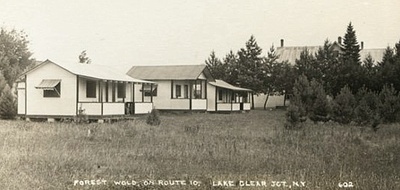 Forest Wold on Route 10 (now Rt 30), c. 1920
Forest Wold on Route 10 (now Rt 30), c. 1920
Courtesy of the Adirondack Experience
Following a "squirrel trail," Northrup and his party finally arrived at their destination on Jock's Lake, where a bark-roofed shanty provided shelter for their first campsite. A trout breakfast revived their flagging spirits and, that night, a successful jackhunt provided venison for the larder. The stay at Jock's Lake was a typical adventure repeated many times at various locations throughout the forest and lake region which, in the 1870s, still had a wilderness flavor.
Subsequent to the original outing, Northrup, in July, was heading south from Malone to reach Fuller's on Meacham Lake for more hunting and fishing. Upon reaching the bottom of the flour barrel he joined a party of guests heading for Paul Smiths. He found the hotel at St. Regis to be a far cry from Jock's Lake. In addition to; the material amenities and the physical comforts, there were real live ladies in the parlor and on the piazza!
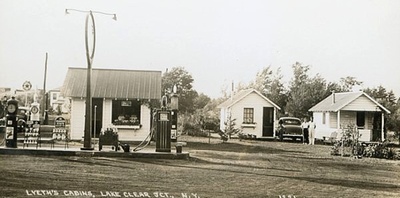 Lyeth's Cabins, Lake Clear, c. 1930
Lyeth's Cabins, Lake Clear, c. 1930
Courtesy of the Adirondack ExperienceAfter a pleasant stay at Paul's, Northrup decided to travel by guideboat to Martin's on Lower Saranac Lake. Rowing through Lower St. Regis, Spitfire, and Upper St. Regis Lakes he came to the first carry. Known as the St. Germain or "Sangemo" carry it ran from the landing at the southern tip of Upper St. Regis to the northern shore of Big Clear Pond. Here dwelt the St. Germain family, where father and sons operated a horse-drawn sled to draw boats and luggage over the carry. As a sideline, the elder St. Germain sold "pop-beer" to the tourists.
 The Cedars, Lake Clear Junction, c. 1920
The Cedars, Lake Clear Junction, c. 1920
Courtesy of the Adirondack ExperienceCrossing Big Clear Pond with some members of another party and a guide, the group arrived at the south shore where another carry led to Upper Saranac Lake. Here at the landing, Northrup noted, only two or three houses in the midst of a, small clearing. After several loud "halloos" by the guide a man with a team of horses appeared to cart the boats over the four-mile carry to Saranac Inn. Although Northrup departed with this conveyance, we will remain at Big Clear Pond.
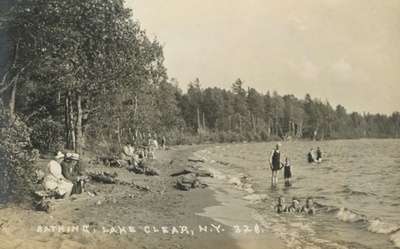 Lake Clear Beach, c. 1920
Lake Clear Beach, c. 1920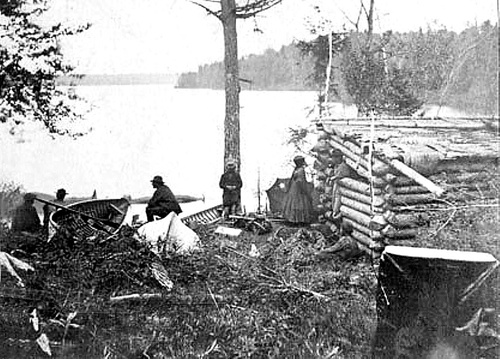 "Big Clear Pond" guide boats and log lean-to, c. 1870
"Big Clear Pond" guide boats and log lean-to, c. 1870
There is a portable darkroom in the lower right corner of image.
Adirondack Views., Fay & Farmer, Malone, N.Y.
Courtesy of the Adirondack Experience
This designation appeared on David Burr's 1839 map of Franklin County and it remained Big Clear Pond in the Stoddard and Wallace guide books prior to the turn of the century. In 1892, the railroad arrived and a junction was formed where the spur to Saranac Lake and Lake Placid shunted from the main line. Perhaps "Big-Clear-Pond-Junction" was just too much of a mouthful but, in any event, the name was reduced to Lake Clear and it has been plain Lake Clear ever since.
In 1906, Paul Smith built an electric railway connecting Lake Clear to his hotel on Lower St. Regis, thus creating another junction at the Lake Clear station. The combined traffic of the two R.R. lines apparently lent an impetus to the growing community and a gradual prosperity evolved. There had been lumbering in the area, even prior to Northrup's visit, when Christopher Norton, "the lumber king of the Saranacs," was busily cutting along the lake's west shore between Big Clear and Little Clear Ponds. The Upper Saranac Association, which owned Saranac Inn, built a dam on Big Clear Pond's outlet, which created a mill pond to operate a sawmill and, later, a hydropowered electric generator to bring electricity to the Inn,
The burgeoning colony of summer camps on the St. Regis chain of lakes brought a welcome boost to the economy of the settlement at Lake Clear. Fred Jarvis ran a stage coach-boat trip from, the Junction to a tour of the lakes which listed the viewing of a total of 50 camp's enroute. The round-trip fare for eight miles of stage-coach riding plus 18 miles of waterway was a modest $2. Food and sundry camp supplies also, meant additional income to Lake Clear merchants due to their proximity to the same 50 camps owned by wealthy patrons. Matt Otis, proprietor of Lake Clear's general store, advertised "Chicago dressed beef, native lamb, veal, and poultry, fresh eggs, butter, milk and cream, along with fish and game in season." Free delivery was offered to all camps.
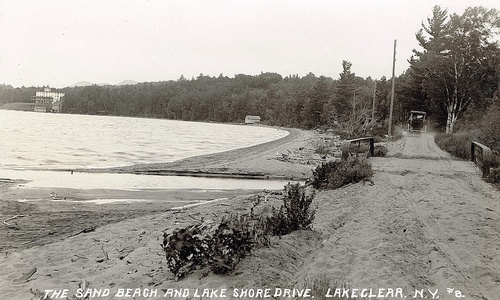 Lake Clear Beach, with the Lake Clear Inn at left.
Lake Clear Beach, with the Lake Clear Inn at left.
Courtesy of Tim MayerThe first public house on Lake Clear was Joe Baker's on the northeast shore. Baker also ran a carry between his place and Upper St. Regis Landing. The hotel changed hands several times over the year with varying degrees of, success and a few name changes. In 1906 it was called Rice's-on-Lake-Clear with Mrs. I. H. Rice, proprietress (no one with pulmonary disease need apply). In 1911, Charles Wardner purchased the property from Rice and it became Wardner's Inn. A remarkable feat was accomplished by Wardner, who formerly leased Rustic Lodge from the Swensons on the southern end of Upper Saranac Lake. When he made his move, he decided to take his cottages with him. During the winter he loaded the seven cabins on horse-drawn sleighs and drew them across the nine miles of ice on Upper Saranac and four miles overland to Lake Clear. The final name for the place was Lake Clear Inn and, although the main building was torn down, the cottages remain in private individual ownership.
Another public house on the west shore was called The Portage and it was operated as a tea room with "exceptional facilities for special luncheons, dinners, and bridge parties" by Helen Conley, until the building burned down. Across the road from the R.R. station was the Junction House run by Solomon LaBounty. Later it became Buckley's Hotel and, presently, is Charlie's Inn.
There were also several boarding houses which prospered under James Gilmett, B.F. Carpenter and Theodore Spear. The extra housing at that time was probably needed because of the many workers employed in nearby occupations. At the Junction there were such R.R. men as station agents, freight agents, section crews, conductors, and engineers. There was the tree nursery, sawmill, and the State Fish Hatchery. Milo Otis was foreman at the hatchery, Charles Holdridge ran the sawmill, and C.R. Pettis was state forester.
The tree nursery has disappeared but the fish hatchery is still in business on the outlet of Little Clear Pond. The railroads are long gone but transportation has taken on new life with the Adirondack Regional Airport which, by the way, is currently making news headlines. The DEC headquarters between Lake Clear and Saranac Inn has grown considerably in both personnel and equipment. The famous Lake Clear wobbler that was invented and manufactured by Harold Robare in Lake Clear is now being turned out in Gilbertsville.
The lake trout, which this popular lure once attracted, have also departed the area, along with the once prolific whitefish. Today it would be quite difficult to locate either the St. Germain or Joe Baker carry. Both of these ancient routes have been displaced by the currently popular "Seven Carries" between Paul Smiths and Saranac Inn which bypasses Lake Clear in favor of Little Clear Pond.
Should A. Judd Northrup be able to cross Big Clear Pond once again he would certainly be surprised to see how the "two or three houses in a clearing" have blossomed into a thriving community, with nowhere to go but up.
Plattsburgh Republican, January 22, 1881
Fire in the Adirondacks.
Bloomingdale, Jan. 17, 1881
Last Tuesday, Jan. 11, between 3 and 4 o'clock; in the afternoon the house of Joseph Baker at Clear Pond in Harrietstown was entirely destroyed by fire, together with the contents. At the time of the fire Mr. Baker and his man were in the woods about half a mile from the house skidding logs, leaving nobody at the house but Mrs. Baker and 4 little children. Mrs. Baker first discovered the fire by water pouring off from the house caused by the melting of the snow. She was working on a sewing machine, the noise of which probably prevented her from hearing the fire sooner, for when she stopped she could hear the cracking and roaring of the fire above, but it was then too late, as the whole of the upper part was in flames, and in a few moments it got down upon them. Mr. Baker saw the smoke, and he and his man got there as soon as possible, but too late to save anything, he found his children in the snow crying. His wife with the assistance of her oldest girl saved the sewing machine, and the children saved some of their Christmas toys, and that was about all. They had about $300 worth of provisions and supplies, included in which was 2 bbls. sugar, 1 bbl. syrup, 1 1/2 bbl. pork, 1 bbl. cider, l 1/3 chests tea, several bbls. flour, and all of his potatoes, of which he had enough to carry him through another season. He estimates their loss at fully $2300, on which he had an insurance of $1000. Mr. Baker has lived there 12 or 14 years, and has worked hard to get together what he had, and was just getting in nice shape to do business. He had a very comfortable house, very nicely furnished and beautifully located on Big Clear Pond, at one end of what is known as Clear Pond Carry on the very popular route from Paul Smith's to Saranac Lakes, Which furnished excellent accommodations for many of the pleasure-seekers passing that way. It will be missed much by many, and it is to be hoped that “Joe” will be able to rebuild.as he was the right man in the right place. Fortunately, his barn and workshop were saved, and his shop having a stove in it made quite comfortable quarters for them till he could get some furniture, bedding, provisions, &c, the only provisions they had being a little bread and butler they succeeded in saving. There is no doubt but that the fire originated from the chimney or stovepipe. Mr. Baker is a very hard-working, industrious, honest man, and has the sympathy and best wishes of the whole community in this very severe loss.
--A Friend.
Malone Palladium, October 6, 1887.
It is reported that PAUL SMITH has purchased from the Mutual Life Ins. Co. a tract of 20,000 acres of land about Big Clear Pond—-including the pond itself, which is a beautiful sheet of water—and many parties are already applying to him for sites for cottages there.
Tupper Lake Herald, April 1, 1921
LAKE CLEAR REAL ESTATE IS ACTIVE
The busy little railroad and fishing town of Lake Clear, above Tupper Lake, on the main line of the New York Central, is enjoying a little real estate boom of its own. During the last few days several important properties have changed hands.
James Buckley has purchased the Junction House, known to hundreds of travelers on the Utica-Montreal run of the New York Central.
Fred Jarvis has purchased from Millard F. Otis the boarding house and farm which Otis has conducted on the lake for thirty years. Jarvis has begun a pulpwood lumbering contract.
A. I. Vosburgh, one of the prominent men of the vicinity of Lake Clear, said today a busy season was expected on the lake this summer. He said he did not believe the present warm weather will continue, as there is always snow in March and April and the weather of the two months is uncertain.
We've got to wait for some time yet," he said, "before the farmers can start operations for the summer and before the recreation seekers begin to come this way."
New York Times, June 13, 1915
One of the largest brook trout ever taken, from Adirondack waters was captured in Lake Clear by Theodore V. Speer, an expert angler. Mr. Speer was using an angle worm as bait and a No. 1 sproat hook trailed behind a No. 2 pearl spoon. The big trout gave battle, and it took some minutes for the angler to conquer it. The trout, a speckled beauty, was twenty-two inches in length and weighed four pounds and nine ounces.
Malone Palladium, April 3, 1890.
The [Franklin County] Board of Supervisors
[…]
An act has been passed creating a separate highway district in Brighton and Harrietstown. Its purpose is to secure the opening of a road from Paul Smith's, passing the shores of Big Clear Pond, and joining the present highway leading from Harrietstown to Saranac Inn. The new road will shorten the distance between Paul Smith's and Saranac Inn by seven or eight miles and also make access to Big Clear Pond easier.
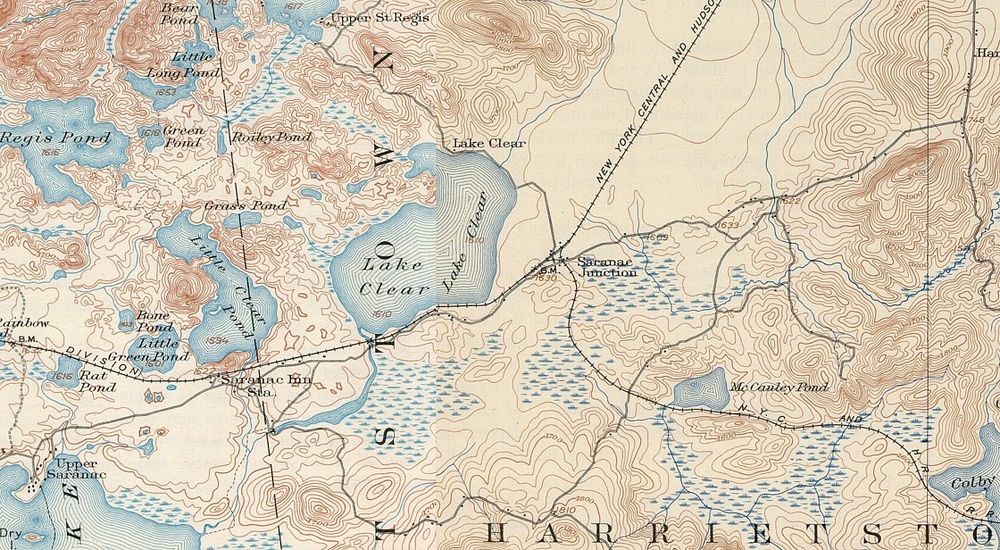 Lake Clear, 1904/1905 USGS maps
Lake Clear, 1904/1905 USGS maps
Comments
Footnotes
1. WBNZ News - "Chamber to Help in Marketing Lake Clear Airport"
2. This article appeared originally on Wikipedia as Lake Clear, New York; its edit history there reflects its authorship. It is licensed under the GDFL.



